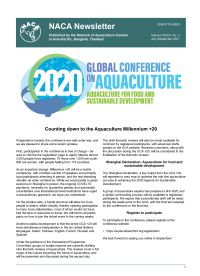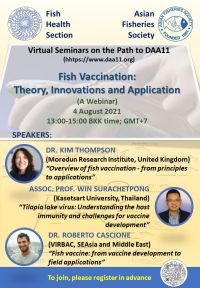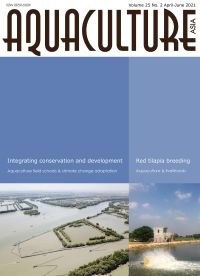In this issue:
Counting down to Aquaculture Millennium +20; Free webinar - Fish Vaccination: Theory, Innovations and Application; Quarterly Aquatic Animal Disease Report, October-December 2020; Invasive disease linked to raw freshwater fish: Group B Streptococcus; International Crustacean Symposium 2021.
FAO will conduct a regional training course on surveillance and monitoring of antimicrobial resistance in aquaculture from 26-30 July, in collaboration with the Institute of Hydrobiology of the Chinese Academy of Sciences and INFOFISH. The course will focus on methodologies relevant to monitoring and surveillance of AMR in major bacterial pathogens of diseased aquatic animals in Asia. The training will be held via video conference. To register for the training sessions, or to view the training programme, please visit the INFOFISH website.
The Fish Health Section of the Asian Fisheries Society (FHS-AFS) is inviting you to a free Zoom webinar on Fish Vaccination: Theory, Innovations and Application. The webinar will be held on 4 August at 13:00 Bangkok time (GMT+7). Please register in advance to attend. After registering, you will receive a confirmation email containing information about how to join the webinar.
In this issue:
Integrated taxonomy, conservation and sustainable development: Multiple facets of biodiversity; A note on 100th birth anniversary of the late Dr Hiralal Chaudhuri; Aquaculture field schools supporting mangroves for climate change adaptation of Indonesian milkfish-shrimp farmers; An insight to red tilapia breeding and culture: A farmer advisory; Aquaculture for livelihoods and food security in North-western India; NACA Newsletter.
In the north-western states of India there is great scope for aquaculture to generate employment opportunities, improve the socio-economic status of farming communities, furnish additional food and nutritional security and boost the national economy. This article describes the present state of Indian aquaculture and prospects for increasing production through diversification, use of village/community ponds and inland saline aquaculture of shrimp and other species, along with major concerns and action plans.



